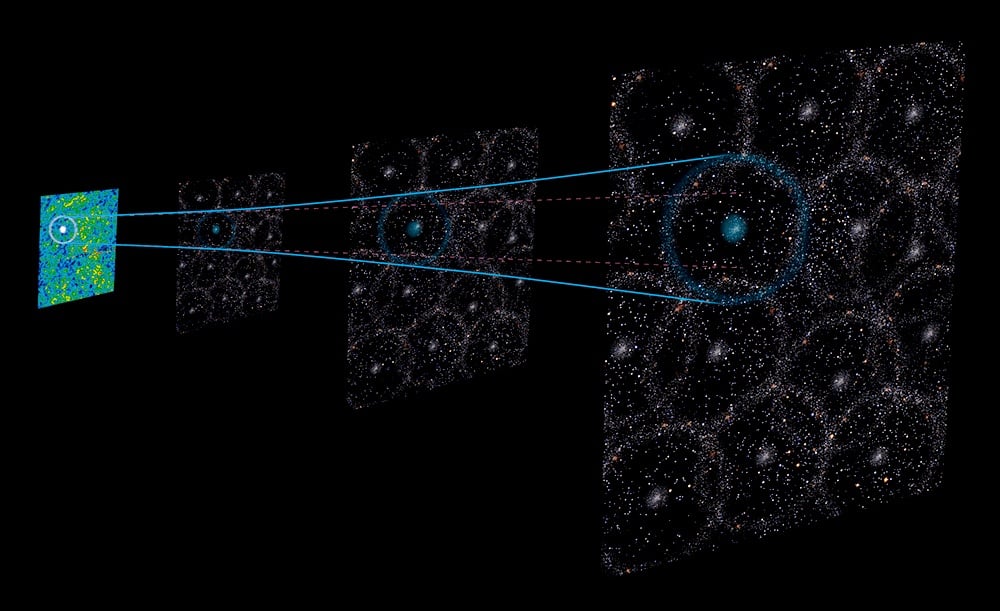One of the main objectives of the Hubble Space Telescope, launched in 1990, was to measure the size and age of the Universe, as well as the rate at which it is expanding (aka. the Hubble Constant). This was enabled for the first time with the Hubble Deep Fields, which visualized the farthest galaxies that are observable in visible light (~13 billion light years from Earth). However, when astronomers measured the distance to these galaxies, they noted a problem: they were inconsistent with measurements of the local Universe. This became known as the “Hubble Tension,” which remains one of the biggest cosmological mysteries to this day.
While astronomers hoped to resolve this tension with the launch of the James Webb Space Telescope, Webb’s measurements confirmed what Hubble saw. Many theories have been advanced to explain this, including the possibility that the Milky Way is located inside a giant void that makes the cosmos expand faster here than in neighbouring regions of the Universe. The latest research supporting this theory was presented at the Royal Astronomical Society’s National Astronomy Meeting (NAM) in Durham. Their theory could potentially resolve the “Hubble Tension” and confirm the true age of our universe (ca. 13.8 billion years old).
The Hubble Constant takes its name from Edwin Hubble, one of two astronomers (the other being Georges Lemaitre) who confirmed in the early 20th century that the Universe was in a state of expansion. This was demonstrated using redshift measurements, where the wavelength of light from objects receding from Earth is shifted toward the red end of the spectrum. Before the Hubble Space Telescope was launched, astronomers were able to gauge the distance of objects up to four billion light years away using a combination of redshift and parallax measurements.
The problem was that when comparing local measurements to those of the distant, early Universe based on the standard Lambda Cold Dark Matter (LCDM) cosmological model, the results were “in tension” with each other. The latest research, explained Dr. Indranil Banik of the University of Portsmouth, shows that baryon acoustic oscillations (BAOs) – essentially the soundwaves of the Big Bang – support the idea that our galaxy could be in a void where cosmic expansion is greater than the Universe beyond:
A potential solution to this inconsistency is that our galaxy is close to the centre of a large, local void. It would cause matter to be pulled by gravity towards the higher density exterior of the void, leading to the void becoming emptier with time. As the void is emptying out, the velocity of objects away from us would be larger than if the void were not there. This therefore gives the appearance of a faster local expansion rate. The Hubble tension is largely a local phenomenon, with little evidence that the expansion rate disagrees with expectations in the standard cosmology further back in time. So a local solution like a local void is a promising way to go about solving the problem.
This void would need to measure a billion light-years in radius and have a density roughly 20 percent lower than the average for the Universe as a whole. This theory is supported by a direct count of local galaxies in our cosmic neighborhood since the number density is lower than in neighboring regions. However, the existence of such a void is inconsistent with the LCDM model, which includes the theory that the Universe is antistropic in nature, meaning that matter is uniformly spread throughout the Universe on large scales. In spite of this, the new data presented at NAM 2025 indicates otherwise. Said Banik:
These sound waves travelled for only a short while before becoming frozen in place once the universe cooled enough for neutral atoms to form. They act as a standard ruler, whose angular size we can use to chart the cosmic expansion history. A local void slightly distorts the relation between the BAO angular scale and the redshift, because the velocities induced by a local void and its gravitational effect slightly increase the redshift on top of that due to cosmic expansion. By considering all available BAO measurements over the last 20 years, we showed that a void model is about one hundred million times more likely than a void-free model with parameters designed to fit the CMB observations taken by the Planck satellite, the so-called homogeneous Planck cosmology.
 Baryon acoustic oscillations (BAOs) – the “sound of the Big Bang” – support the idea of a local void. Credit: Gabriela Secara/Perimeter Institute
Baryon acoustic oscillations (BAOs) – the “sound of the Big Bang” – support the idea of a local void. Credit: Gabriela Secara/Perimeter Institute
To confirm this theory, researchers must compare the local void theory with other models to obtain new estimates for the expansion history of the Universe. This will consist of obtaining spectra from quiescent or “dead galaxies” (those no longer forming new stars) to determine what types of stars they have and in what proportion. Since massive stars have short lifespans and are absent from older galaxies, this will help astronomers establish the age of these galaxies. Combined with a galaxy’s redshift, astronomers can chart the history of cosmic expansion.
Further Reading: Royal Astronomical Society


